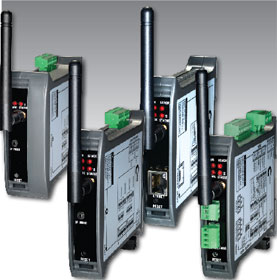

Calog Instruments has launched the WG range of wireless gateways for applications that require low data rates and wireless mesh networking across large areas.
These employ the Modbus/RTU protocol, simplifying setup and integration with PLCs, and offer a variety of communication methods and topologies to suit different needs for small, medium or large networks.
The gateways can be used to network entire factories or plants, and are ideal for a host of monitoring and control applications, including smart energy/grid, automatic meter readings (AMR), lighting controls, tank monitoring, building automation systems, HVAC control, and medical devices and laboratories.
Unlike Bluetooth or Wi-Fi devices, this system’s nodes are connected to each other by multiple pathways. This enables routes to be created between nodes that would otherwise be out of range, allowing the network to be extended across a much wider area. It also increases the stability of the network, because data can easily be rerouted if any node malfunctions.
Calog WG nodes can transmit approximately 80 metres (provided line of sight) and up to 97 nodes can be connected in a single network (1 base, 64 remotes and 32 sleepers). Connections between nodes are dynamically updated and optimised through sophisticated mesh routing tables. New nodes can be added as needed, and will be automatically incorporated into an existing network.
The dual-function WG-PTH pathfinder base/remote unit can be used as either a base node or a remote node, and is the starting point for setting up a Modbus-to-wireless mesh network. It is configured as a Modbus slave device for easy integration with PLCs, and is available with optional digital I/O and serial output options include RS-232, RS-485, RS-422 and Ethernet Modbus/RTU.
WG-SLB and WG-SLR wireless sleepers operate as standalone devices, and send data to the base node at user-configured intervals. They integrate seamlessly with existing WG mesh networks, and enable additional network topologies and functions.
The WG-SLB can be powered by either a power supply or long-life lithium batteries, and conserves power by sleeping between transmissions. Because of this, it cannot be used as a route point for other nodes. The WG-SLR is powered by a supply and so is constantly online and able to provide routes for other remote nodes and sleepers.
| Tel: | +27 10 595 1831 |
| Email: | [email protected] |
| www: | www.instrotech.co.za |
| Articles: | More information and articles about Instrotech |

© Technews Publishing (Pty) Ltd | All Rights Reserved